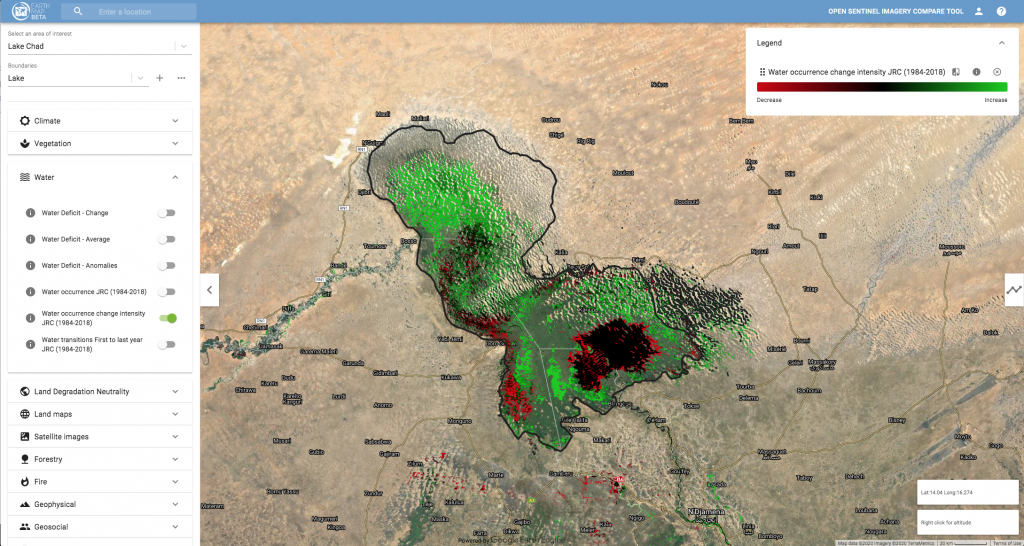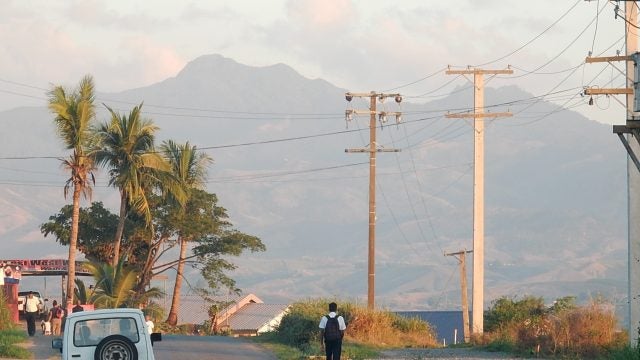Title: Ecosystem Restoration as an Immunization for Humanitarian Crisis: The Case of Lake Chad
It may come as a surprise to many readers, but since 2005, Lake Chad has stopped shrinking; in fact, it has actually stabilized in the last two decades, reaching more than 13,000 square kilometers today. The conflict surrounding Lake Chad continues to be one of the world’s most challenging conflict-traps (a cycle of economic deterioration and repeat conflict), with seasonal migration of people in search of natural resources such as fuelwood, fish, water, and arable land to sustain their livelihoods.
In order to stop the conflict around Lake Chad, a concerted effort of many stakeholders is needed to build a new future for the area with social and environmental contracts based on trust, security, and resilience in the face of climate change. Such efforts should build on existing programs such as Africa’s Great Green Wall, a regional sustainable plant-based solutions to improve the resilience of human and natural systems through land restoration.
The effects of climate change on the lake are clear: temperatures in the region are increasing 1.5 times faster than the global average, and precipitation is highly variable and increasing over time. These changes, combined with more extreme weather events due to climate change, contribute to increased variability of the size of the lake and thus exacerbate the ongoing conflict over limited resources. The Food and Agriculture Organization of the United Nations (FAO) classified twenty-eight percent of the people in the region as a returnee (a person who was a refugee, but who has recently returned to his or her country of origin). As local populations exploit wood for cooking and other daily needs, deforestation and forest degradation around the lake are increasing, which lead to decimated fish populations, increased wind speeds, and greater soil erosion and land degradation.
In order to return stability to the region and break out of the protracted conflict-trap, the impacts of climate change must be tackled as part of peacebuilding efforts and food security. One of the ten points proposed in the report “Shoring Up Stability” is the need for climate change adaptation and natural resource management. These principles are the entry points for the following discussion surrounding Lake Chad by first assessing climatic and vegetation variables for further insights on how to build resilient livelihoods.
Assessing Vegetation Variables
The FAO has developed a tool called Earth Map with the support of Google and funding from Germany’s International Climate Initiative. It gives easy, yet precise, access to historical satellite data to facilitate climate and natural resources analysis on a global scale. Earth Map allows anyone to examine local climate data and other variables, such as vegetation changes, anywhere in the world (see Figure 1 for Lake Chad). In the past, this was a costly and time-consuming exercise that few developing countries could afford.

Figure 1: Screenshot of Earth Map with Lake Chad Outlines and Calculations through the Interface
The change in the intensity of surface water occurrence — the frequency of occurrence of water on the land surface over a given time period — takes place over seasons and multiyear periods. Surface water occurrence variations are critical for agriculture and pastoralist. Figure 2 illustrates how the water occurrence intensity changed between 1984 and 2018, where the northern part of the lake experienced an increase, while the southern and western sides underwent a decrease. These changes can affect water available for fishing, agriculture, and pastoralism, thus impacting food security and economic stability in the region. Furthermore, the Normalized Difference Vegetation Index (NDVI), an index that quantifies vegetation by comparing the difference between near-infrared (which vegetation strongly reflects) and red light (which vegetation absorbs), shows that the vegetation in Lake Chad is on an upward trend (Figure 3).

Figure 2. Change in water occurrence intensity (1984-2018). Green indicates an increase in the intensity of water occurrence while red indicates a decrease in the intensity of water occurrence
based on the European Commission’s Joint Research Centre Global Surface Water Explorer

Figure 3. Normalized Difference Vegetation Index (NDVI) (Landsat 30m)
based on USGS Landsat 7 Surface Reflectance Tier 1
Many villages across Lake Chad have been abandoned or destroyed due to the conflict. Unsurprisingly, nature has claimed its course, evidenced by discernible vegetation recovery in many abandoned villages within just a few years (Example 1, Example 2, Example 3 as shown in Figure 4). Thus, there is important tree restoration potential around the Lake (Figure 5 and Table 1).
 Figure 4. Examples of abandoned or destroyed villages and natural vegetation restoration over time.
Figure 4. Examples of abandoned or destroyed villages and natural vegetation restoration over time.
The first image is a bird’s eye view of the locations of the three examples. The changes across time can also
be visualised in full with a slider Example 1, Example 2, Example 3 (click on each example).

Figure 5. Tree restoration potential for Lake Chad (snapshot from Earth Map)
based on Bastin et al. 2019 – The Global tree restoration potential
Table 1. Tree Restoration Potential for Lake Chad in Hectares (ha)
based on Bastin et al. 2019 – The Global Tree Restoration Potential
| Area Total | 1.875.159 ha |
| Total Potential – Tree Covered Area | 386.697 ha |
| Restoration Potential – Tree Covered | 112.588 ha |
Building Resilient Livelihoods through Restoration
According to climatic and vegetation data, there is an opportunity for ecosystem restoration to a productive condition in the Lake Chad region. Using this assessment as an entry point, the extension of already ongoing restoration activities, such as the Great Green Wall in Lake Chad, is an opportunity to lay the foundations for resilient livelihoods and stable peacebuilding. Launched in 2007, Africa’s Great Green Wall is an ambitious initiative of the African Union to address continuous land degradation issues associated with the limited socio-economic development of rural communities in the drylands at the edge of the Sahara, stretching from the Atlantic Ocean to the Red Sea. Beyond planting trees, the program also addresses complex social and governance issues that characterize much of the Sahel. Discussions on how to scale up the Great Green Wall in the Lake Chad region have been ongoing for years with various partners. Overall, regional restoration efforts should integrate climate change adaptation and mitigation as well as land-use planning. Any solution must be based on responsive and accountable governments that respect human rights to build economic and social protection systems which ensure that communities are not left behind, but rather benefit from development. The time for action has come now, especially with an increase of displaced people returning to the region.
Today, decision-makers have all the necessary information and tools to act at their fingertips. The information presented in this analysis was freely accessible tools with tools such as Earth Map. Accessibility is crucial to attracting greater support for restoration efforts, both at the global and local levels, particularly for ecosystem restoration in the Lake Chad region.
Often when examining crises, developed countries focus on consequences more than causality, especially in forced migration issues. Through addressing land restoration programs in Lake Chad, leaders can focus on the origin of the problem. In recent months, after more than a decade of armed conflict, the humanitarian crisis in north-east Nigeria is deepening and the need for action is ever more urgent. The Great Green Wall initiative should be expanded in the Lake Chad region by integrating agroforestry, climate-smart agriculture, and sustainable lakes and rivers management, and land-use planning, altogether building on restoring the region’s tree potential. By strengthening the work of the Great Green Wall, conflict can be reduced, and Lake Chad can be saved.
. . .
Dr. René Castro-Salazar is the current Assistant Director-General for the FAO’s new Climate, Biodiversity, Land, and Water Department. He was previously the Assistant General-Director for the FAO Forestry Department. Dr. Castro-Salazar has held several ministerial positions in Costa Rica between 1994 and 2014, including Minister of Natural Resources, Minister of Foreign Affairs, and Minister of Environment and Energy. He holds a Master’s of Public Administration and a Doctorate of Design from Harvard University.
Moctar Sacande is a tropical seed physiologist with a PhD from Wageningen University, the Netherlands, and an expert in large-scale dryland restoration. He is the International coordinator of ‘’Action Against Desertification,’’ which implements the Africa’s Great Green Wall restoration program on the ground.
Danae Maniatis is an environment and development specialist with over 10 years of wide-ranging experience in tropical forestry, climate change and finance, biodiversity conservation, partnership development, land-use and cover assessments, and international policy development and implementation. She holds a Master’s of Science and a Doctorate of Philosophy from the University of Oxford.
Danilo Mollicone is a forest ecologist who specializes in the use of remote sensing data to observe forests and to assess land-use changes processes. He was a visiting scientist at the Max Planck Institute for Biogeochemistry and at the European Union Joint Research Centre. For more than 10 years, he has coordinated and implemented land-use related projects at the FAO.
Recommended Articles

Export controls on AI components have become central tools in great-power technology competition, though their full potential has yet to be realized. To maintain a competitive position in…

The Trump administration should prioritize biotechnology as a strategic asset for the United States using the military strategy framework of “ends, ways, and means” because biotechnology supports critical national objectives…

Fiji, a Pacific Small Island Developing State (PSIDS), faces rural electrification challenges due to its dispersed geography and climate vulnerabilities. With 6 percent of Fijian rural households lacking…